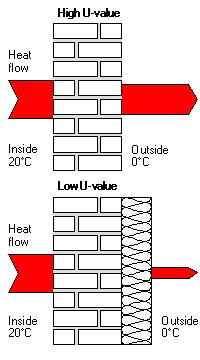U-Values
What is a U-value?
The U-Value (thermal transmittance) of a building element is a measure of the rate of heat flow through the build up of the material layers of the element. The calculation of the U-value takes into account heat lost through the building element by the processes of conduction, convection and radiation.
U-values are expressed as the rate (in Watts [W]) at which heat transfers through 1 square metre [m²] of the surface of a building element when there is a temperature difference of 1 Kelvin [K] (=1ºC) between the internal and external environments.
From this definition, we can see that U-Values are expressed in W/m²K.
Lower U-values indicate better thermal insulation. For example a wall with a U-value of 0.3 W/m²K losses heat at half the rate of a wall with a U-value of 0.6 W/m²K.
| A note on temperature differences The standard scientific unit of temperature is the Kelvin, which is represented by the symbol "K". The Kelvin scale has a different starting point to that used by the Celsius temperature scale, so a temperature of 1K is not the same temperature as 1ºC. The scales are, however, calibrated so that a temperature difference of 1K is the same as a temperature difference of 1ºC. Building fabric heat losses are calculated with reference to temperature differences between one side of a construction and the other. When we see internal and external temperatures expressed in ºC, the temperature difference across the construction will have the same value whether expressed in ºC or K. For example, a temperature difference of 20ºC is the same as a temperature difference of 20K. The standard scientific unit of temperature is the Kelvin, so that's the unit of temperature that's used when expressing U-values. |
Why U-values matter
Using building components with low U-values (i.e. good) has a number of advantages:
- It saves money
- It’s good for your health
- It gives better indoor thermal comfort
A house built with low U-value building components will use less energy and thus the building owner saves money on their energy bills. Good U-value building components increase the surface temperature on the inside which is critical in preventing surface mould growth. Good U-values also improve the indoor thermal climate and create healthy buildings for their residents.
Our BuildDesk U software tool can be used to calculate U-values for new and existing building constructions, and can also be used to calculate critical surface temperatures and interstitial condensation risk.

